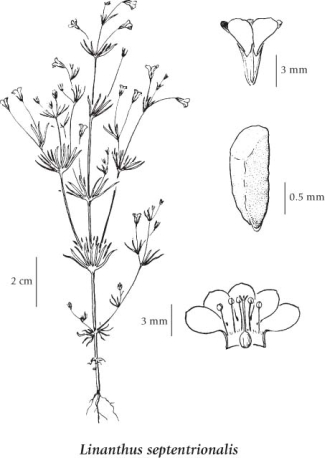Leptosiphon septentrionalis (H. Mason) J.M. Porter & L.A. Johnson
northern linanthus (northern flaxflower)
Polemoniaceae (Phlox family)
Introduction to Vascular Plants
northern linanthus (northern flaxflower)
Polemoniaceae (Phlox family)
Introduction to Vascular Plants
Map
Distribution of Leptosiphon septentrionalis
Click here to view the full interactive map and legend
Species Information
General:
Annual herb from a taproot; stems often branched, hairless or minutely hairy in part, 5-25 cm tall.
Leaves:
Opposite, unstalked, palmately cleft into 3 to 7 segments 5-20 mm long, or the uppermost leaves entire, the segments thread-like, fringed with bristly hairs; leaves of the inflorescence longer than those below and more densely fringed.
Flowers:
Inflorescence an open, branching, terminal cluster of flowers solitary on long thread-like stalks in the forks and at the ends of the branches; corollas white, lavender or pale blue, yellow in the throats, 2.5-6 mm long, about 1.5 times as long as the calyx, the short funnel-shaped tube spreading to five lobes and with a ring of short hairs in the throat; calyces 1-3 mm long, the 5 teeth lance-triangular.
Fruits:
Capsules, 3-chambered; seeds 2 to 8 per chamber, swelling and becoming sticky when moistened.
Illustration

If more than one illustration is available for a species (e.g., separate illustrations were provided for two subspecies) then links to the separate images will be provided below. Note that individual subspecies or varietal illustrations are not always available.
Illustration Source: The Illustrated Flora of British Columbia
Ecology
Ecological Framework for Leptosiphon septentrionalis
The table below shows the species-specific information calculated from
original data (BEC database) provided by the BC Ministry of Forests and Range.
(Updated August, 2013)
The table below shows the species-specific information calculated from
original data (BEC database) provided by the BC Ministry of Forests and Range.
(Updated August, 2013)
| Site Information |
Value / Class |
||
|
Avg |
Min |
Max |
|
| Elevation
(metres) |
1373 | 838 | 1880 |
| Slope
Gradient (%) |
41 | 8 | 70 |
|
Aspect (degrees) |
208 | 100 | 238 |
| Soil
Moisture Regime (SMR) [0 - very xeric; 4 - mesic; 8 - hydric] |
2 | 1 | 4 |
| Modal
Nutrient Regime
Class |
D | ||
| #
of field plots species was recorded in: |
10 | ||
| Modal
BEC Zone Class |
ESSF | ||
|
All BEC Zones (# of stations/zone) species was recorded in |
ESSF(4), IDF(2), MS(3), PP(1) | ||
|
Source:
Klinkenberg 2013
|
|||
Habitat and Range
Dry slopes, meadows, sagebrush flats and forest openings in the steppe and montane zones; rare in SC and SE BC; E to SK and S to WY, CO and CA.Status Information
Synonyms
Synonyms and Alternate Names:
Gilia septentrionalis (H. Mason) H. St. John
Linanthus harknessii var. septentrionalis (H. Mason) Jeps. & V. Bailey
Linanthus septentrionalis H. Mason